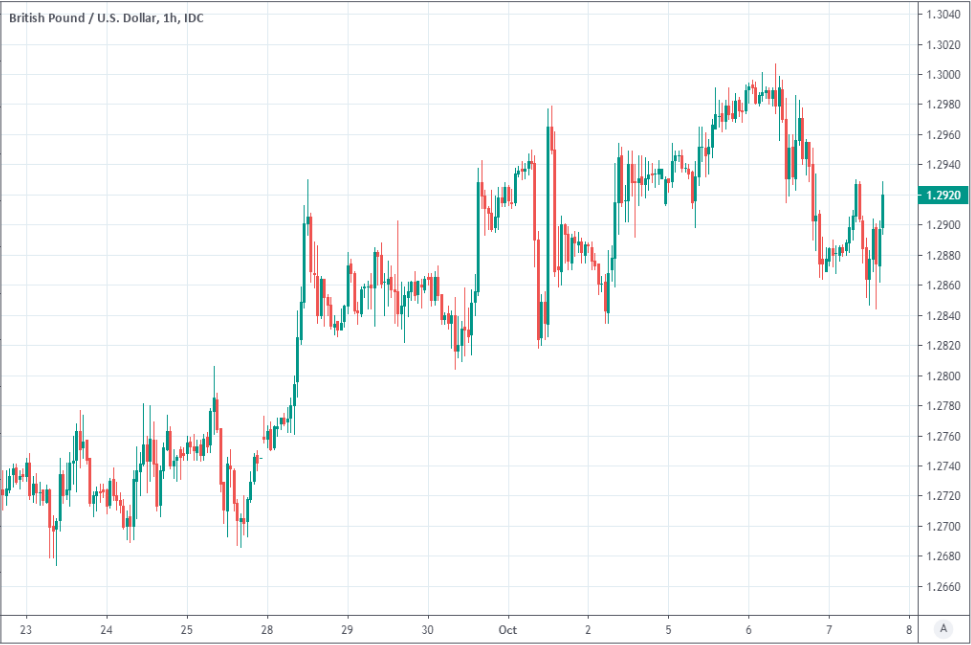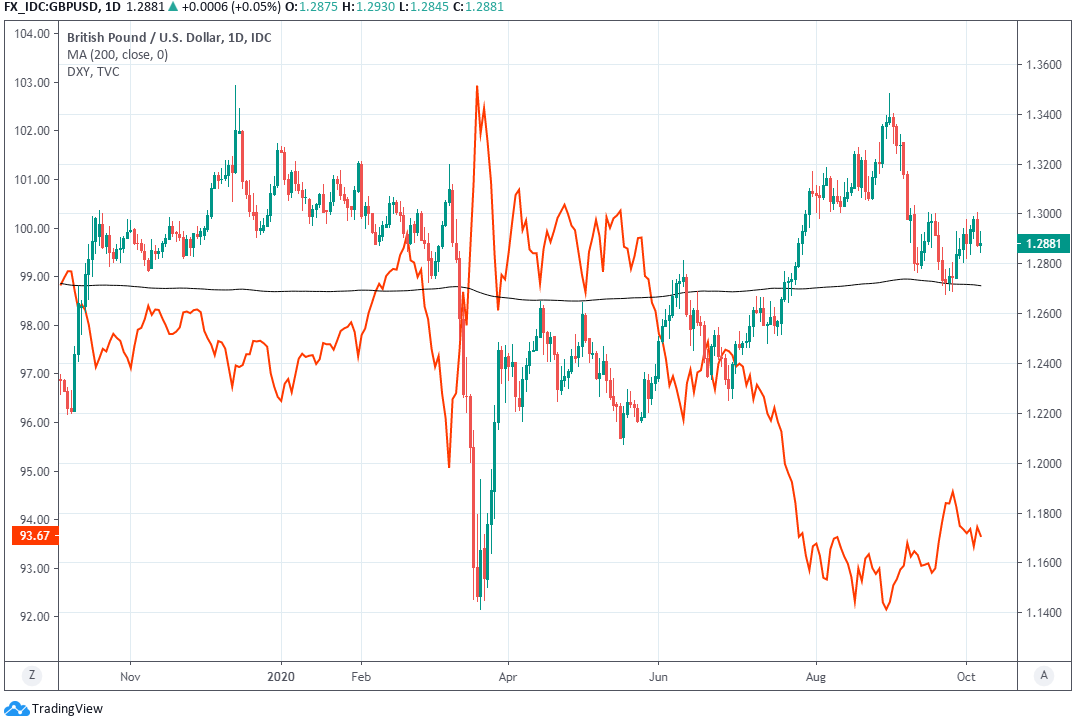Pound-Dollar Outlook Still Blotched by Brexit Uncertainty in 2021 as Trade Talks Set to Drag On
- Written by: James Skinner
-
-2021 forecasts upgraded amid signs trade talks to be extended.
-But further GBP declines likely in short-term as noise level rises.
-As UK, EU face year-end choice between extension and 'no deal'.
-GBP wallows in losses as Frost tells Lords 'no deal' still on table.

Image © David Holt, Accessed: Flikr, Licensing Conditions: Creative Commons
- GBP/USD spot rate at time of writing: 1.2878
- Bank transfer rate (indicative guide): 1.2432-1.2622
- FX specialist providers (indicative guide): 1.2690-1.2767
- More information on FX specialist rates here
The Pound-to-Dollar rate outlook may be marred by Brexit uncertainty long after year-end amid increasing signs that trade talks could be extended into next year, which have already produced volatility but at the same time, led some forecasts for the British currency to be upgraded.
At the very best political leaders, businesses and households will only have an “outline agreement” on the terms of the future UK-EU trade relationship when the transition period ends on December 31, British negotiator David Frost told a House of Lords committee on Wednesday, indicating that some form of extended transition may be necessary to avert a ‘no deal’ exit.
Frost told the UK’s upper chamber that he and his team are still waiting on decisions to be taken by the EU but that “quite good” progress has been made in the talks of late including in key areas that have so-far stymied a broader agreement, before cautioning that a deal still remains some way off.
He also reiterated Prime Minister Boris Johnson’s weekend assertion that he'd be willing to trade with the EU on the same terms as Australia if differences between the two sides remain too large to be bridged, keeping alive and well the prospect of a ‘no deal’ Brexit from the transition period at year-end or after.
“There are no hard deadlines in politics, why we think the two sides could come up with a “smart” postponement instead”,” says Andreas Steno Larsen, chief FX strategist at Nordea Markets. "They could decide to outline a deal, but agree that a new implementation period is needed. That would in practice resemble a postponement, but would be “sold as a deal.”

Above: Pound-to-Dollar rate shown at hourly intervals.
For a second time Prime Minister Johnson and EU chief executive Ursula Von der Leyen agreed at the weekend to have negotiators work with increased energy and vigour in order to reach an agreement, even as they acknowledged that “significant gaps remained, notably but not only in the areas of fisheries, the level playing field, and governance.” They already agreed a similar objective in September, to much fanfare at the time but little avail in the talks.
Brussels continues to demand automatic access to British fisheries, the level of which would be negotiated annually, and a continued authoritative say in matters of economic policy as the price of a free trade agreement. It says the arrangements are necessary for the protection of its single market, given the size of the UK economy and its close proximity to the European Union.
Just talked to @BorisJohnson
— Charles Michel (@eucopresident) October 7, 2020
The EU prefers a deal, but not at any cost.
Time for the UK to put its cards on the table. #EUCO #15-16October
So far the differences of opinion over its demands have prevented an agreement from being struck and the clock is now ticking after the British government repeatedly refused earlier in the year to contemplate making a request for an extension of the transition period.
Failure to agreed a deal or an extension of the standstill transition should lead to the imposition of tariffs on goods travelling back and forth between the EU as well as a range of other policy changes, although Nordea’s Larsen sees scope for the two sides to agree a fudge, effectively, that would avert a return to tariffs but prolong uncertainty about the end-state relationship.
“This could lead to a moderate GBP recovery in 2021, but uncertainty will remain elevated,” Larsen says, before upgrading forecasts for Sterling.
Nordea now looks for the Pound-to-Dollar rate to rise to 1.37 and a post-referendum high by June 2021, an upgrade from 1.34, but still envisages a decline from 1.28 to 1.26 by year-end as market nerves are tested only for a covert extension of the talks to be announced under the guise of a partial deal.

Above: GBP/USD with 200-day average in black. Rising as Dollar Index declines amid weakness in U.S. exchange rates.
Both sides are working to agree terms ahead of an October 15 European Council summit that is widely billed by British media as a walkaway point for PM Johnson, although the closest thing to a real deadline is December 31 and even then some including Nordea see a chance that this is extended.
“It remains difficult to judge whether the sides are making genuine progress,” says Shahab Jalinoos, head of FX strategy at Credit Suisse. “We continue to feel that levels above GBPUSD 1.30 should be sold until there is more visibility.”
Shankar Singham, head of trade at the Centre for Economics and Business Research and an adviser who’s popular with the Brexit-supporting parts of the ruling Conservative Party, told a parliamentary Brexit committee last month that an “implementation period” might yet prove necessary and indicated that under certain circumstances the government could agree one.
Ministers have staunchly resisted demands and protested suggestions that they consider another extension of the current standstill transition period, which has preserved many of the features of EU membership since January 31 2019, for fear of undermining the country’s position in the negotiations.
But Singham’s comments indicate flexibility, which is notable for the Pound not only because he’s influential with the governing party but also because the current transition was originally conceived and then sold to the electorate as an “implementation period,” before the term was eventually abandoned.
“We are concerned that even in the best-case scenario of a deal unfolding, it will probably require concessions on the UK side,” Jalinoos says. “This may require PM Johnson to make it appear as if matters went “to the brink” and that what “experts” consider a cave in, is in fact a Churchillian moment of glory that goes hand in hand with indicators such as soaring UK market and GBP rally (both in reality being recoveries following a plunge first). This certainly fits with the scenario that unfolded in October 2019 after Johnson’s concessions on Northern Ireland opened the door for the Withdrawal Agreement.”

Above: Pound-to-Dollar rate shown at weekly intervals.




